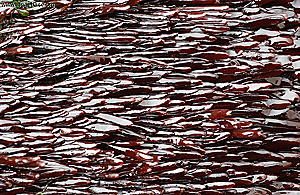Seaweed harvesting in Ireland
Seaweed harvesting in Ireland currently employs about 400 people in a mostly part-time capacity. It is quite clear, however, that the situation is deteriorating rapidly. Recruits are few as people are less and less willing to engage in such "dirty" work that is so weather- and tide-dependent. "Blackweed" collection has ceased in the last 10 years (Table 3)--mainly due to declining markets and increasing affluence--and there has been a precipitous decline in pickers willing to gather carrageen moss, and, despite considerable demand, dulse. It is likely that the jobs mainstay of the industry, Ascophyllum nodosum harvesting, will see a similar decline in harvesters over the next 10 years. In general, it will become increasingly difficult to get the younger people of the western seaboard to collect seaweed.
 What can we do about this? For a start, there is no doubt that we need urgently to examine the mechanisation of wrack and kelp collection and seaweed cultivation in general.
What can we do about this? For a start, there is no doubt that we need urgently to examine the mechanisation of wrack and kelp collection and seaweed cultivation in general.
Mechanisation of harvesting
Mechanisation has been successfully applied in similar situations in a number of other countries, notably Norway and France. In Norway, both Ascophyllum and Laminaria hyperborea are harvested mechanically using a range of custom-built devices and boats (Briand 1991). These can, with experimentation, be adapted to Irish environmental conditions, which are no more severe than they are in Norway. There are several Norwegian solutions for Ascophyllum harvesting and these need to be tested in Ireland. In France, the "scoubidou" is used extensively for the harvesting of Laminaria digitata (Briand 1991) and there is no reason again why it cannot be used in Ireland. Less manpower will be needed in seaweed harvesting, but the remaining jobs will be more worthwhile in terms of skill and rewards.





